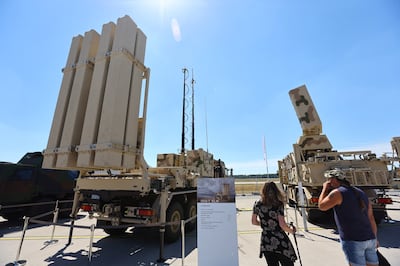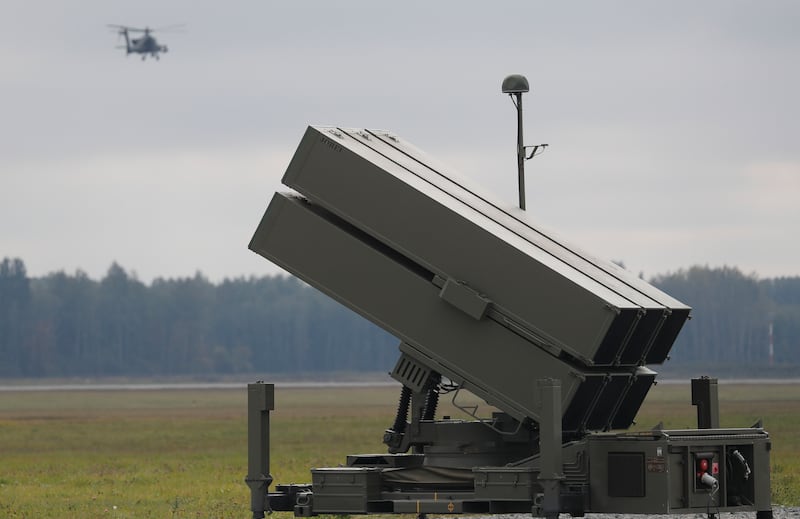Ukraine has been inundated with large quantities of western weaponry since the outbreak of war with Russia.
Until now, the focus has been on short-range systems such as the Stinger AD SAM man-portable air defence systems from the US and Starstreak from the UK.
But an air defence system is what Kyiv really desires. Both Germany and the US had pledged to provide medium-range ordnance some months ago but so far, none has materialised.
It appears that Russia's renewed aerial bombardment has galvanised Berlin to act on its promise, saying a batch of medium-range Iris-T SLMs is now just days away.
Similarly, the US is expected to speed up delivery of eight Nasams — National Advanced Surface-to-Air Missile Systems — that President Joe Biden promised to Ukraine in the summer.
Ukraine's current armoury is ill-suited to fighting the biggest aerial threats facing the country: out-of-sight fast aircraft releasing high-altitude missiles and other weapons.
What is the Iris-T SLM air defence system?
Developed by German manufacturer Diehl, Iris-T SLMs are part of Nato's Medium Extended Air Defence System which replaced the Patriot missile system.
Mounted on the high-mobility Man 8×8 vehicles, they are low altitude weapons designed to counter attacks from manned aircraft, drones and cruise and ballistic missiles — including those with nuclear capacity.

A single Meads battery can provide air defence over an area nearly eight times as great as the Patriot could. It also requires just two operators and takes only eight minutes to deploy.
The enhanced functionality was achieved using near-vertical launching, advanced radars and the ability to carry and launch up to eight lorry-mounted missiles.
One of these radars is an all-weather, high-performance 360-degree surveillance radar which means the system can hit multiple targets simultaneously at a range of up to 40 kilometres and an altitude of 19km.
How much does the Iris-T SLM air defence system cost?
Each radar-guided battery comes at a cost of €140 million ($136m).
When Germany originally promised to send 11 batteries to Ukraine four months ago, German Chancellor Olaf Scholz said these would “enable [Ukraine] to protect an entire city against Russian air raids”.
While the precise reason for the delay is unclear, the order went direct to Diehl which allegedly has been awaiting an export licence from Berlin, according to a report in the UK's Times newspaper.
What is the Nasams defence system?
This missile is the product of a joint enterprise between Norwegian firm Kongsberg Defence and Aerospace and US weapons manufacturer Raytheon.
It is known for its use of the Raytheon Amraam missile but is also able to operate a range of guns and short and medium-range missiles and can be integrated with longer range systems such as the Iris-T SLM.
Like the Iris-T SLM, it can track and destroy a range of manned and unmanned aircraft and is calibrated to protect high-value assets and highly populous areas. The US uses Nasams to protect the White House and the Pentagon.
According to military news website Army Recognition: “The purpose of the Nasams multi-missile launcher is to transport, aim and fire missiles with different characteristics, all mounted on the same launch rail inside the protective canisters.”

Each battery comprises three or four AN/TPQ-36 surveillance, acquisition and tracking radar systems, nine truck-mounted missile launchers, each with six Amraam missiles, and three or four truck-mounted MSP 500 electro-optical sensors for visual target identification and raid size assessment.
The launcher can be remotely controlled from up to 25km and can fire the six Amraams at six different targets concurrently.
A total of 12 launchers in battalion configuration can fire up to 72 missiles in under 15 seconds.
What is the cost and when will the US send Nasams to Ukraine?
The cost of one Nasams battery is $23 million with one Amraam missile costs more than $1.2 million.
A US Department of Defence briefing in late September confirmed the US had yet to send any of the eight Nasams promised to Ukraine.
However, at the briefing a US general said two would be delivered within the next couple of months.
US Secretary of State Antony Blinken spoke with Ukrainian Foreign Minister Dmytro Kuleba on Monday to reiterate US support, but a date for delivery of the remaining six batteries is still to be established.






